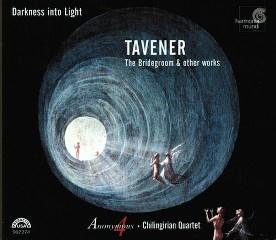John Tavener - Darkness into Light (2002)
John Tavener - Darkness into Light (2002)

1. Vespers hymn: O lux beata trinitas 2. Jube domine / Lection: In principio 3. John Tavener: Come and do Your will in me (voices & strings) 4. Compline Hymn: Christe qui lux es 5. Lectio ysaye prophete / Lection: Surge illuminare 6. John Tavener: As one who has slept (voices & strings) 7. Nocturn hymn: Medie noctis tempus est 8. Leccio libri apokalipsis / Lection: Vidi civitatem 9. John Tavener: The Lord's Prayer 10. Alleluia: Quinque prudentes virgines 11. John Tavener: The Bridgeroom (voices & strings) 12. Hymn for the New Light: Inventor rutili Anonymous 4: Marsha Genensky Susan Hellauer Jacqueline Horner Johanna Maria Rose Chilingirian Quartet: Levon Chilingirian, violin Charles Sewart, violin Asdis Valdimarsdottir, viola Philip De Groote, cello Recorded February 10-15, 2002
John Tavener fans have a world-premiere to savor and followers of Anonymous 4 get to hear the acclaimed quartet do more of what it does best. What’s not to like? On the surface, we’re bathed in gorgeous sound–both in terms of the music itself and the clear, resonant, nicely balanced recording. The medieval plainchant and polyphony, selected from the Divine Office and mass, includes the beautiful hymns O lux beata trinitas, Christe qui lux es, and Medie noctis tempus est (sung in Anonymous 4’s trademark perfect unison), as well as three “medieval lections” whose two-part scoring features lines that bounce freely among open fourths and fifths, unisons, and octaves. And if you know any of Anonymous 4’s previous work, you’re not surprised here at the singers’ amazing technical precision, uniformity of phrasing, and absolute one-ness of sound in these very challenging pieces.
Most of the rest of the program consists of four works by John Tavener, three of which are scored for voices and strings, the other (The Lord’s Prayer) for voices alone. The Bridegroom, written in 1999 for Anonymous 4 and the Chilingirian Quartet, receives its world-premiere recording here, and suffice to say, in all of its 17 and one half minutes we hear nothing we haven’t heard before in numerous other Tavener works. In fact, the pieces on display here clearly reveal the rather formulaic nature of much of his writing: predominance of close-scored dissonances; slow-moving, mostly stepwise chordal structure that involves much forward/backward motion and repetition, almost invariably centered in a minor “key”; very short phrases marked by regular, distinct pauses; drones supporting bursts of high-lying melodies, often harmonized in thirds and sixths. There’s little of what we normally think of as rhythm, and once Tavener latches onto a melodic or harmonic idea he likes, he never lets go of it. In fact, he makes entire pieces out of almost nothing, just by repeating the simplest fragment–ad nauseam. When he’s through with an idea, he just dumps it and begins another; when he runs out of words–as in The Lord’s Prayer–he just stops.
Granted, the music is almost invariably pretty, sometimes even truly if momentarily exciting. The earliest Tavener work here, As one who has slept, is very appealing in its simplicity–and along with the equally ingratiating The Lord’s Prayer could serve as a summation of his recent style, whose scale of superficiality is surpassed only by the composer’s astonishing pretentiousness (which we should be used to by now), exemplified here in his directions to performers: “The music must be sung with enormous intensity and sonority, casting all into the fire of God”; “The music [of The Bridegroom] should be almost unbearable in its ecstatic light . . . the female voices [represent] the people in the world, full of that longing which is a kind of Divine eros.”
What exactly the performers are supposed to do with this information is anyone’s guess, but at least the Chilingirians and Anonymous foursome make it all sound very sonorous and genuinely, sincerely felt (if not quite “unbearable” or fully “cast into the fire of God”). Considering the great temporal distance between the medieval works and those of Tavener, the program actually coheres and flows very well–but for me, the juxtaposition only reinforces my conviction that those anonymous church composers of long-past centuries are far more compelling in (and perhaps largely because of) their anonymity than a certain all-too-self-aware 21st-century composer whose presumptions of greatness never will garner him a place in their exalted company. ---David Vernier, classicstoday.com
download (mp3 @320 kbs):








